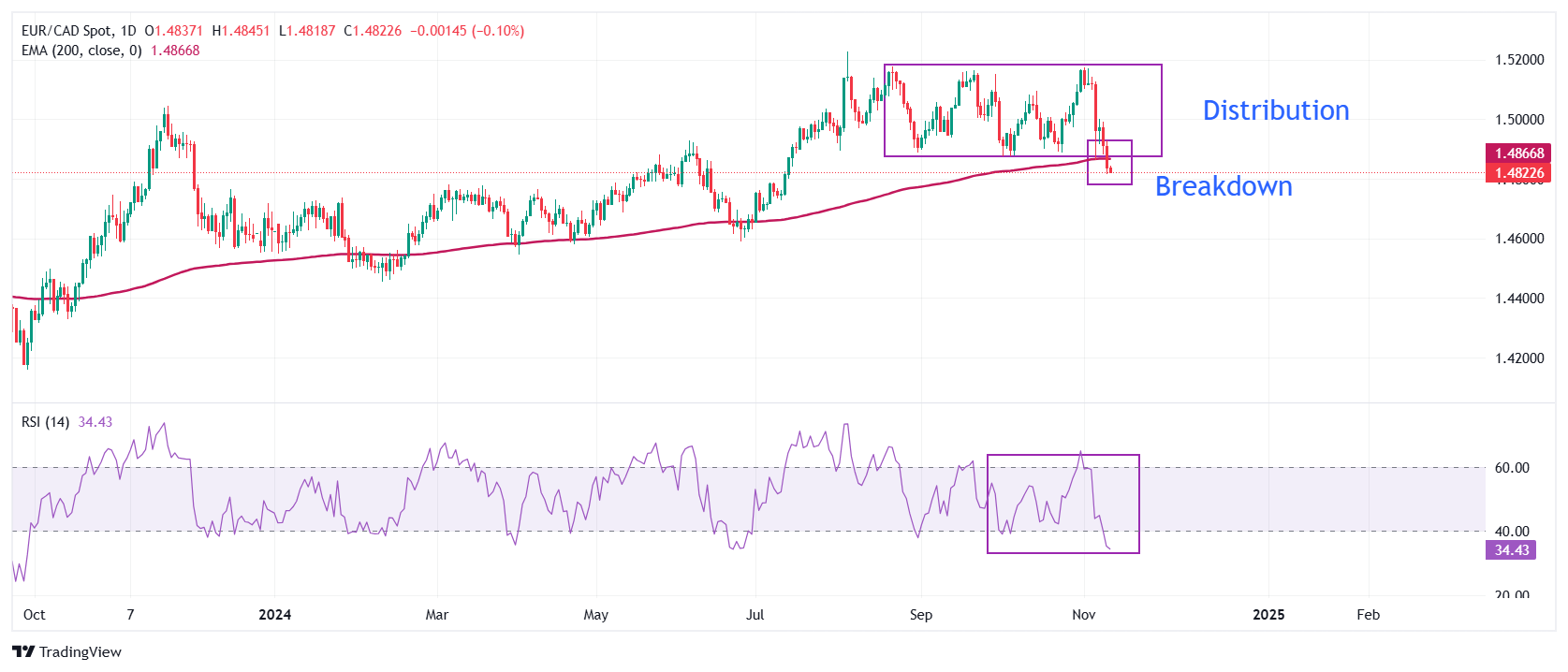EUR/CAD Price Forecast: Sees more downside below 1.4800
- EUR/CAD weakens as the EURO faces selling pressure across the board.
- Trump’s victory and German political uncertainty have weighed on the Euro.
- The BoC is expected to cut interest rates by 50 bps next month.
The EUR/CAD pair trades close to more than a three-month low around 1.4820 in European trading hours on Tuesday. The cross extends its losing streak for the third trading day on Tuesday as the Euro (EUR) remains on the backfoot across the board.
The Euro faces intense selling pressure on Republican Donald Trump’s victory in United States (US) presidential elections who vowed to raise import tariffs by 10% universally in his election campaign. Though the impact should be seen on all trading partners of the US, the Euro appears to be a bigger victim, with Trump mentioning in his election campaign the euro bloc will "pay a big price" for not buying enough American exports.
Meanwhile, German political uncertainty after the collapse of the three-party coalition has also weighed on the Euro, challenging the economic growth by paving the way for a confidence vote on December 18 and a snap election on February 23, according to a report from Focus Online.
Though investors have underpinned the Canadian Dollar (CAD) against the US Dollar (USD), its outlook remains weak on growing expectations that the Bank of Canada (BoC) will cut interest rates further. The BoC is expected to reduce its key borrowing rates by 50 basis points (bps) again in the December meeting.
EUR/CAD delivers a breakdown of the Distribution formation on a daily timeframe in which the asset is transferred from institutional investors to retail participants, which results in a bearish reversal. The longer-term trend of the asset has also turned bearish as it has slipped below the 200-day Exponential Moving Average (EMA), which trades around 1.4866.
The 14-day Relative Strength Index (RSI) slides below 40.00, adds to evidence of more downside ahead.
The cross could decline to the July 10 low near 1.4730 and the round-level support of 1.4700 after breaking below the July 12 low near 1.4800.
On the flip side, a recovery move above the November 11 high of 1.4927 will drive the asset towards the psychological resistance of 1.5000 and the October 28 high of 1.5045.
EUR/CAD daily chart

Euro FAQs
The Euro is the currency for the 19 European Union countries that belong to the Eurozone. It is the second most heavily traded currency in the world behind the US Dollar. In 2022, it accounted for 31% of all foreign exchange transactions, with an average daily turnover of over $2.2 trillion a day. EUR/USD is the most heavily traded currency pair in the world, accounting for an estimated 30% off all transactions, followed by EUR/JPY (4%), EUR/GBP (3%) and EUR/AUD (2%).
The European Central Bank (ECB) in Frankfurt, Germany, is the reserve bank for the Eurozone. The ECB sets interest rates and manages monetary policy. The ECB’s primary mandate is to maintain price stability, which means either controlling inflation or stimulating growth. Its primary tool is the raising or lowering of interest rates. Relatively high interest rates – or the expectation of higher rates – will usually benefit the Euro and vice versa. The ECB Governing Council makes monetary policy decisions at meetings held eight times a year. Decisions are made by heads of the Eurozone national banks and six permanent members, including the President of the ECB, Christine Lagarde.
Eurozone inflation data, measured by the Harmonized Index of Consumer Prices (HICP), is an important econometric for the Euro. If inflation rises more than expected, especially if above the ECB’s 2% target, it obliges the ECB to raise interest rates to bring it back under control. Relatively high interest rates compared to its counterparts will usually benefit the Euro, as it makes the region more attractive as a place for global investors to park their money.
Data releases gauge the health of the economy and can impact on the Euro. Indicators such as GDP, Manufacturing and Services PMIs, employment, and consumer sentiment surveys can all influence the direction of the single currency. A strong economy is good for the Euro. Not only does it attract more foreign investment but it may encourage the ECB to put up interest rates, which will directly strengthen the Euro. Otherwise, if economic data is weak, the Euro is likely to fall. Economic data for the four largest economies in the euro area (Germany, France, Italy and Spain) are especially significant, as they account for 75% of the Eurozone’s economy.
Another significant data release for the Euro is the Trade Balance. This indicator measures the difference between what a country earns from its exports and what it spends on imports over a given period. If a country produces highly sought after exports then its currency will gain in value purely from the extra demand created from foreign buyers seeking to purchase these goods. Therefore, a positive net Trade Balance strengthens a currency and vice versa for a negative balance.

